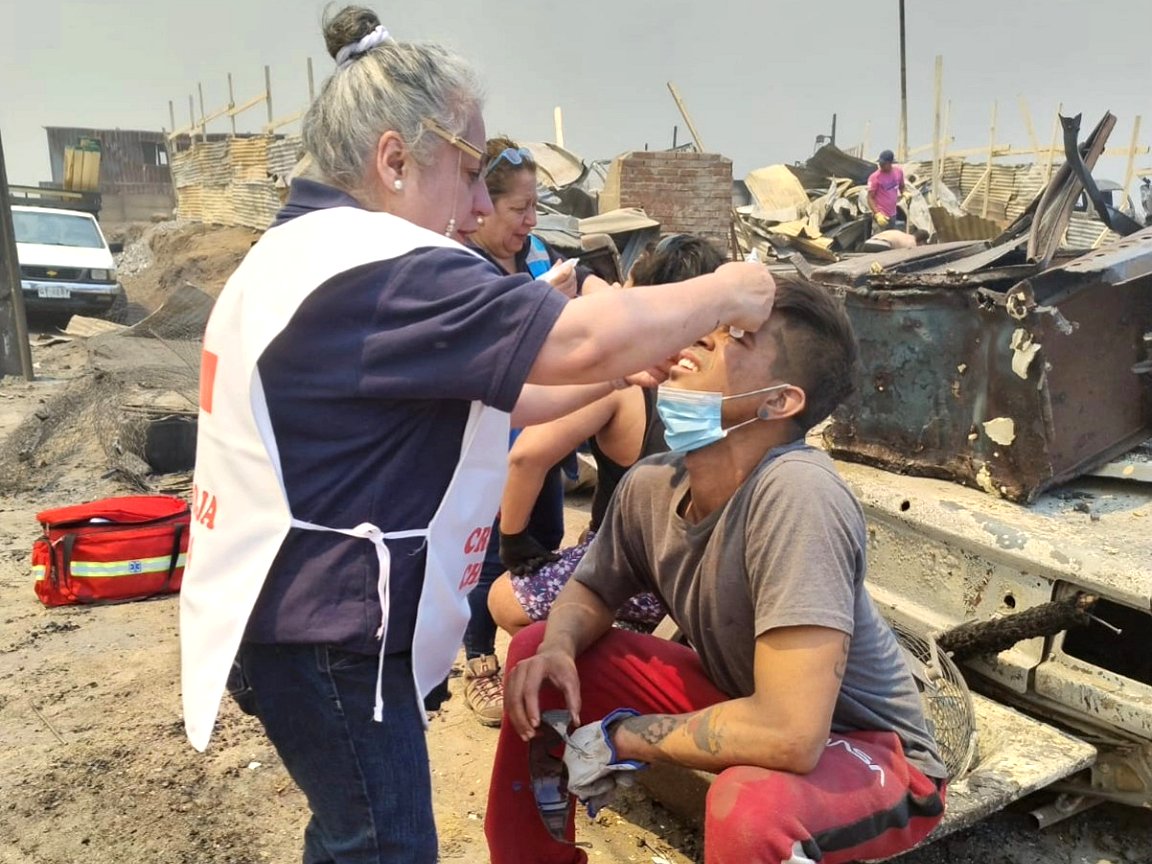
‘Extreme fire-weather in Chile driven by climate change and El Niño’

By the Climate Centre
(Update: the IFRC Monday 12 February issued an emergency humanitarian cash grant of half a million Swiss francs to help the Chilean Red Cross assist nearly 10,000 people affected by the fires, which it says have had “profound consequences” and are notably worse than similar wildfires a year ago.)
The Chilean Red Cross was today continuing to assist thousands of people affected by the wildfires that the UN now says are believed to be the deadliest on record in the country, collecting aid in kind donated by residents all over the country, and partnering with a local bank to expedite online donations.
The Red Cross is also assisting on the ground with first aid (photo) and has set up a hotline to help family members separated by the fires to re-establish contact.
A full account of the Chilean Red Cross response to the disaster – which President Gabriel Boric earlier this week described as the “biggest tragedy” since the 2010 earthquake – is now available (in Spanish) via an IFRC X/Twitter space.
“The inhabitants of Viña del Mar, of Quilpué, of Villa Alemana, have gone through and are experiencing a situation that has been tremendously catastrophic, exceptional, unprecedented and painful,” President Boric said.
Chilean authorities said Tuesday that 131 bodies had been recovered from burnt-out neighbourhoods.
Destructive seasons
The fires in Chile come two weeks after Colombia declared a disaster as nearly 30 wildfires continued to rage there out of more then 300 since November, UNDRR noted, adding that a 2022 report by the UN Environment Programme anticipated a global increase of extreme fires of up to 14 per cent by 2030 “due to climate change and land-use change”.
In Chile, wildfires have “dramatically risen in recent years” in Chile, according to a study published late last month in Nature journal, which researched the 2022–23 southern hemisphere summer fire-season. Nearly 2 million hectares have been ravaged by wildfires over the past ten years, the study says, three times the amount for the preceding decade, with all but one of the seven most destructive seasons observed since 2014.
“Fire weather conditions (including high temperatures, low humidity, dryness, and strong winds) increase the potential for wildfires, once ignited, to rapidly spread,” the Nature authors write, while “the concurrence of El Niño and climate-fuelled droughts and heatwaves boost the local fire risk and have decisively contributed to the intense fire activity recently seen in central Chile.”
Megadrought
Juan Bazo, the Climate Centre’s regional representative for Latin America, said today: “There is clear evidence that climate change and variability, including ENSO, have a significant relationship to fires in Chile, especially in the past decade when they’ve been increasingly extreme.
“Unprecedentedly severe droughts and heatwaves are closely linked to wildfires and are having a serious impact on the most vulnerable communities.”
Additional investments in adaptation and resilience that may be needed in the light of intensifying climate impacts include “include improving the country’s Early Warning System (EWS), a critical tool to take early action, reduce disaster risk, and support climate adaptation,” the Nature article adds.
“These systems allow forecasting hazardous weather and help to minimize impacts by opportunely informing governments, communities, and individuals.”
For much of the last decade, Chile has also been in the grip of what is termed a megadrought – the longest since records began, heightening the risk still further.
The Chilean Red Cross is continuing to assist people affected by catastrophic wildfires, collecting aid in kind donated from all over the country, and partnering with a local bank to expedite online donations. (Photo: CRC via social media)